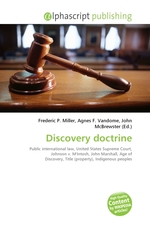Discovery doctrine
Frederic P. Miller, Agnes F. Vandome, John McBrewster
бумажная книга
The Discovery Doctrine is a concept of public international law expounded by the United States Supreme Court in a series of decisions, most notably Johnson v. M'Intosh in 1823. The doctrine was Chief Justice John Marshall's explanation of the way in which colonial powers laid claim to newly discovered lands during the Age of Discovery. Under it, title to newly discovered lands lay with the government whose subjects discovered new territory. The doctrine has been primarily used to support decisions invalidating or ignoring aboriginal possession of land in favor of colonial or post-colonial governments. John Marshall, who is most credited with describing the doctrine, did not voice wholehearted support of the doctrine even while using it to justify judicial decisions. He pointed to the doctrine as simple fact, looking at the possession-takings which had been supported by it as things which had occurred and had to be recognized. The supposedly inferior character of native cultures was a reason for the doctrine having been used, but whether or not that was justified was not relevant for Marshall.
Данное издание не является оригинальным. Книга печатается по технологии принт-он-деманд после получения заказа.


